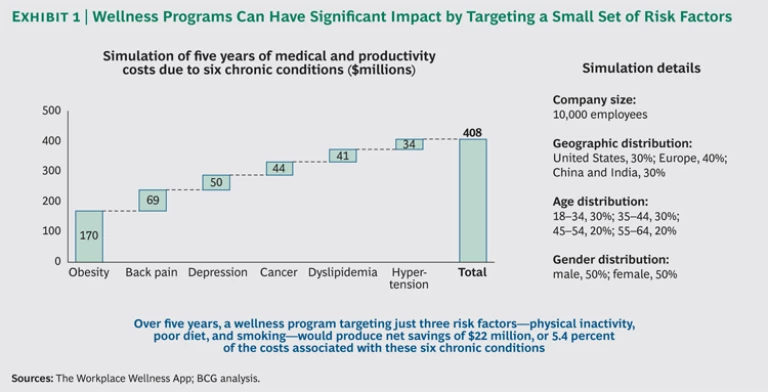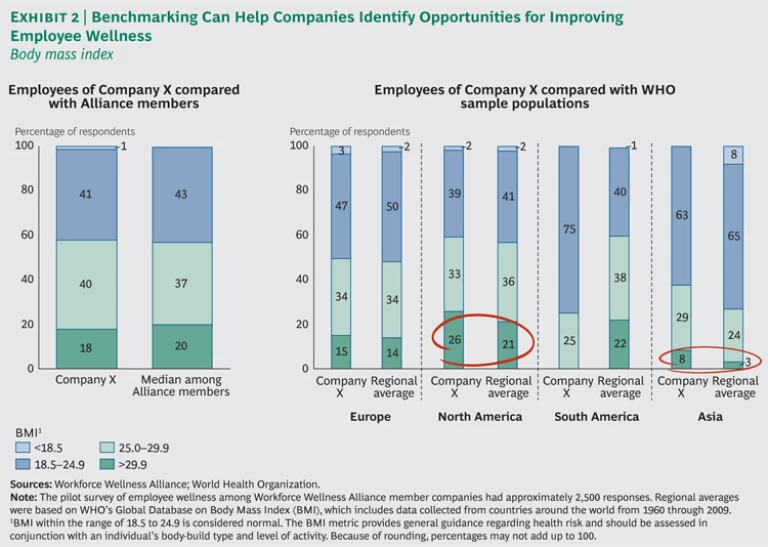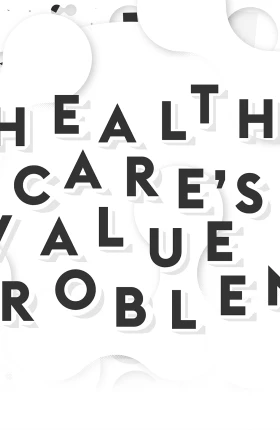No one doubts that having a healthy workforce makes a huge difference to a business’s bottom line: the cost of chronic disease, in terms of lost productivity, runs to trillions of dollars each year. Still, companies have had a hard time justifying large investments in employee wellness programs, largely because there is a profound lack of understanding of how specific tactics can affect employees’ health. In the absence of compelling evidence or clear direction, many companies either view chronic disease as someone else’s problem, or they develop initiatives that are well-intentioned but minimally effective. They struggle to motivate employees who are at risk but not yet sick, to prioritize the risk factors they should attack, and to measure success in terms of both employees’ wellness and their productivity.
If a global coalition of companies could agree on a set of standardized metrics and reporting protocols to track the effectiveness of specific wellness initiatives, employers could learn from one another’s progress and missteps. Companies could then leverage these insights to mount increasingly effective, targeted actions against a small set of pivotal risk factors—including smoking, inactivity, and stress—that give rise to the most costly chronic diseases. Making wellness a common cause can also enhance our collective capability to learn how to mitigate health risks and prevent them from turning into disease and lost productivity.
With this idea of corporate collaboration as a foundation, the World Economic Forum worked closely with industry leaders such as Humana and The Boston Consulting Group to create the Workplace Wellness Alliance. The Alliance was launched at the World Economic Forum in Davos in January 2010 and already lists more than three-dozen corporate members among its growing ranks. The intent is to make the consortium as broad as possible so that, together, corporations can tackle a problem that exacts a profound human and economic toll.
Wellness Matters
Chronic disease is a global plague. According to the World Health Organization (WHO), 60 percent of deaths worldwide are attributable to chronic illnesses such as cardiovascular disease, diabetes, and cancer. Close to half of those whose death is the result of chronic disease die when they are still in their “productive years,” according to a 2009 report from the World Economic Forum. The human toll is tragic, but the economic cost cannot be overlooked either. An estimated $2 trillion in economic activity—or more than 3 percent of global GDP—is lost each year because of absenteeism and “presenteeism” (employees’ being at work when they are not healthy and are therefore less productive) attributable to just four chronic-disease risk factors: tobacco use, physical inactivity, unhealthy diet, and harmful alcohol use. (See “The New Discipline of Workforce Wellness: Enhancing Corporate Performance by Tackling Chronic Disease,” World Economic Forum, 2010.)
In light of such tremendous losses, one might assume that the chronic-disease umbrella covers an overwhelming number of discrete conditions, making the problem too complex to tackle. This, in fact, is not the case. Fifteen conditions account for 80 percent of the economic loss due to chronic disease, and these conditions are linked to just eight risk factors: smoking, physical inactivity, poor diet, alcohol consumption, poor standard of care, poor stress management, insufficient sleep, and lack of health screening. Addressing just a subset of these eight modifiable behaviors can yield enormous benefits for individuals as well as companies. A 2010 project sponsored by BCG, Healthways, and the World Economic Forum estimated that by targeting just three key risk factors, U.S. employers could save an average of $700 per employee per year in reduced health-care costs and recouped productivity. Following the same approach, European employers could save an average of €400 per employee annually.
BCG and Healthways also developed a simulation model that—based on a company’s demographics and the risk factors the company chooses to target—estimates the savings that a wellness program could generate. For example, the model showed that a company with 10,000 employees could reduce the costs associated with six chronic diseases by 5.4 percent over five years by targeting physical inactivity, poor diet, and smoking. (See Exhibit 1.)
Providing a Framework to Promote Wellness
In their recent book about the health care crisis (Chaos and Organization in Health Care, MIT Press, 2009), Thomas H. Lee and James J. Mongan cited chaos as the primary challenge in disease treatment. Health care and disease treatment knowledge is being generated across thousands of medical settings and is accumulating so quickly that, simply unable to organize and deploy it effectively, we are creating more confusion than enlightenment. Although this knowledge can lead to greater specialization and advances at a local level, it overwhelms any effort to coordinate care for certain patient categories (for example, by promulgating best practices). The antidote to this sort of chaos is organization—of information, people, and treatments.
Overcoming chaos may also be the key to preventing disease. There is some consensus that employers, with their access to a large at-risk population of working-age adults, are uniquely positioned to address chronic disease. But the task of improving employees’ health can be daunting—largely because there is no shared wisdom about the best way to encourage behaviors that mitigate risk factors. Consequently, many companies either avoid dealing with the problem or develop initiatives that are long on goodwill but short on substance.
Most wellness programs fail, for example, to link specific tactics—typically a mix of interventions and incentives—with their impact on employees’ health (and, in turn, productivity). In fact, a lot of programs are justified on the basis of good employee and public relations and responsible management—not on a tangible return on investment (ROI). Companies are also inclined to address wellness by partnering with advocacy or community groups—for example, sponsoring a walk against diabetes—but they struggle to effect the changes that matter most: zeroing in on the risk factors that not only have a demonstrable impact on employees’ health but also can be addressed through proven strategies, motivating employees to take preventive measures to safeguard their health, and tracking results.
To make meaningful progress in the fight against chronic disease, companies need to work together to identify pivotal risk factors, design programs to mitigate them, and measure outcomes. Participating in a global coalition will invariably lead to richer, more powerful insights. The Workplace Wellness Alliance provides the structure and processes for companies to do just that, primarily through two Web-based resources: a knowledge repository and a metrics database. The global nature of these resources is what sets the Alliance apart from other wellness efforts, most of which focus on only one company or region.
- Knowledge Repository. The repository serves a vital function by providing a platform for collaborative learning and continuous improvement. Members are encouraged to share best practices and case studies describing the design and implementation of successful wellness programs. In addition, companies can post tools and employee education materials that help other members jump-start their own programs.
- Metrics Database. The Alliance’s metrics initiative kicked off in December 2010 with a pilot survey of member companies’ employees. The survey, which was designed for companies that do not regularly perform health risk assessments (HRAs), asked respondents about certain behaviors linked to risk factors such as tobacco use, exercise, fruit and vegetable consumption, alcohol consumption, and general stress levels, as well as biometrics such as height, weight, and waist circumference. Companies that conducted HRAs were able to leverage their existing data rather than having to conduct additional employee surveys. The input form included the same categories as the survey, but it also asked questions about cholesterol levels, blood pressure, and fasting glucose levels, which are commonly included in HRAs.
Tracking metrics is particularly critical to the success of the venture. In addition to helping identify employees’ behaviors and conditions that pose the greatest danger to health and productivity, the database also allows companies to build a business case for wellness interventions, mainly by providing a baseline of employees’ health. Companies can predicate their wellness initiatives on a target ROI and evaluate the progress of their initiatives against the baseline.
Fast Results and Long-Term Aspirations
Although the Alliance is relatively new, the metrics database already includes about 135,000 responses from 11 companies, giving participants enough information to pinpoint opportunities for action. In gathering and assessing data on employees’ body mass index (BMI), one of the participating companies found significant variations across different regions. (See Exhibit 2.) With these results and bearing in mind relevant nuances in local customs and health-care practices, the company was able to explore why some regions were better able to mitigate certain risk factors, and it could then apply these lessons to regions where the risk factors remained high.
In addition to the benefits of benchmarking, Alliance members have opportunities to collaborate with international organizations such as WHO and the International Labour Organization to develop and codify initiatives for promoting wellness. They also have access to a comprehensive repository of data on disease management, tools for evaluating interventions and employees’ health (using consistent metrics), and a network of thought leaders on wellness. The Alliance is not short on aspiration. It aims to become the global authority on chronic-disease prevention and management, setting the standard for nongovernmental organizations, governments, and the private sector in the fight against one of the world’s most vexing and costly problems. To this end, the Alliance is seeking to become as broad as possible—in terms of industries, governments, regions, and company size (Fortune 500 companies as well as small and medium-sized enterprises).
It is not unrealistic to think that the Alliance, within a matter of years, will have gathered millions of data points from hundreds of companies. Once the Alliance gains momentum, its members will set a virtuous cycle in motion. Insights about effective initiatives will be disseminated among members, providing greater traction for wellness programs and more data points on outcomes.
The Alliance represents a breakthrough in the battle against chronic disease. It provides a means for companies to collaborate and share data about interventions and outcomes, and—perhaps most important—to identify a set of best practices that are proven to have a tangible impact on employees’ health. By organizing the chaos surrounding the difficult problem of global wellness, the Alliance promises to deliver significant, sustained impact.
To learn more about the Workplace Wellness Alliance and how to participate, please visit http://alliance.weforum.org.







